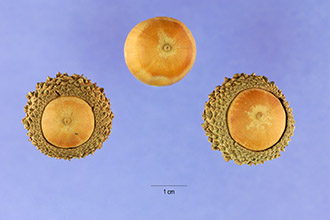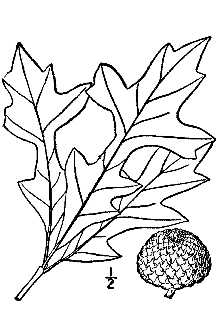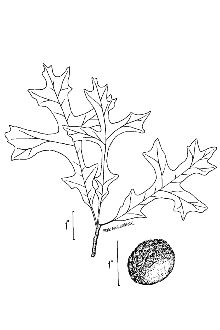Overcup Oak
Scientific Name: Quercus lyrata Walter

| General Information | |
|---|---|
| Usda Symbol | QULY |
| Group | Dicot |
| Life Cycle | Perennial |
| Growth Habits | Tree |
| Native Locations | QULY |
Plant Guide
Alternate Names
Swamp post oak, swamp white oak, water white oak
Uses
Wood of overcup oak is brownish, hard, heavy, and strong; it is marketed as white oak primarily for lumber and cooperage but is not consistently valued for quality products because of fire damage and defects from wood borers and heartwood decay following fire injuries. Checking during drying and seasoning often prevents general use even as ties and timbers. In some areas, this species has been avoided in cutting and has increased in dominance at cut-over sites. Overcup oak is planted to improve wildlife habitat and for bottomland restoration. Ducks, wild turkeys, hogs, white-tailed deer, squirrels, and smaller rodents eat the acorns. Overcup oak also is planted as an ornamental. The trees can withstand significant flooding and poorly drained soils and are tolerant to drought and cold. In spite of its natural occurrence where periodical flooding is typical, overcup oak grows best on sites with better drainage and soil texture. Robert H. Mohlenbrock USDA, NRCS, Wetland Science Institute @ PLANTS
Status
Please consult the PLANTS Web site and your State Department of Natural Resources for this plant’s current status, such as state noxious status and wetland indicator values.
Description
General: Beech Family (Fagaceae). Native trees commonly growing to 18–30 m tall, often with a short trunk and open, irregularly rounded crown; bark light gray, becoming furrowed into scaly plates and ridges. Leaves are deciduous, alternate, generally obovate to elliptic-oblong in outline but highly variable, 13–21 cm long and 4–10 cm wide, basally wedge-shaped, with 5–9 deep, rounded lobes, shiny dark green above, usually paler gray-green below and variably hairy, turning red, yellow, or brown in fall. Male and female flowers are borne in separate catkins on the same tree (the species monoecious) on the current year's branchlets. Acorns maturing in the first year, nearly round, nearly globose to broadly ovoid (broadest near the base), 12–25 mm long, with a warty gray cup almost enclosing 2/3 to nearly all of the acorn, with acute scales. Common name from the acorn almost entirely enclosed in the spherical cup. Overcup oak is a member of the white oak subgroup (subgenus Quercus) and hybridizes with other related species, including white oak (Q. alba), swamp white oak (Q. bicolor), Durand oak (Q. durandii), bur oak (Q. macrocarpa), swamp chestnut oak (Q. michauxii), post oak (Q. stellata), and live oak (Q. virginiana). Variation within the species: Variants within the species are not recognized.
Distribution
This plant is native to the Atlantic and Gulf coastal plains from southeastern Virginia to panhandle Florida and westward to east Texas, north in the to Missouri, Illinois, and Indiana, with scattered populations in northern Alabama, central Tennessee, Delaware, and Maryland. For current distribution, please consult the Plant Profile page for this species on the PLANTS Web site.
Establishment
Adaptation: Overcup oak usually occurs on clay or silty-clay flats in first bottoms and terraces of larger streams and rivers. It is also common on the edges of swamps and bayous and in poorly drained depressions or sinkholes. Overcup oak may be dominant and climax in stands with water hickory (Carya aquatica) on low, backwater flats and other sites commonly flooded for 30–40% of the growing season. Tolerance to late spring floods results partly from its phenology -- it leafs out a month or more later than most species. Many stands of overcup oak owe their development to tolerance of early season flooding that kills off earlier flushing species. Overcup oak is relatively intolerant of shade. Suppressed young trees respond strongly to release when the canopy is opened by disturbance. The heavy, wet, clay soils where overcup oak typically grows restrict root development to relatively shallow depths. Seedlings initially produce taproots, but these are soon replaced by a shallow, lateral root system. Flowering occurs in (March–)April–May, with appearance of new leaves, sometimes as long as a month after sympatric species and it fruits in September–October. General: Overcup oak begins to produce seed at about 25–30 years; good crops are produced every 3–4 years. Overcup oak acorns have a unique spongy shell that renders them buoyant. They are disseminated primarily by water, buoyed by a spongy shell. After winter dormancy, they germinate in the spring after floodwaters recede. Good germination occurs on moist soils when acorns are covered by leaves. Seeds germinate profusely beneath complete canopy, but the seedlings succumb or at least die back to the root collar within 3 years unless released. Flooding during the first few growing seasons also produces high mortality of seedlings. Height growth of overcup oak is slower than many associated species, causing it to be overtopped easily. Maximum age is about 400 years. Stumps of small trees sprout vigorously but not consistently after top-kill.
Management
Prolonged drought in bottomlands may lead to surface fires that kill overcup oak seedlings and saplings and damage bark of larger trees, Such minor injuries open trees to infection by heart rot fungi, Young overcup oak trees may sprout after top-kill by fire, Use soil moisture sensors to measure the soil moisture of Overcup Oak., Natural reforestation of bottomland oldfields now favors tree species that tolerate dry soils because a large proportion of formerly wet sites are subject to flood control, Since overcup oak is dependent on overflow or floodwaters for seed dispersal, it has to be planted on these sites if its presence is desired, Nuttall oak (Quercus nuttallii) is often used to replace overcup oak on sites that have reduced flooding or stream flow, Cultivars, Improved and Selected Materials (and area of origin) These plant materials are readily available from commercial sources, Contact your local Natural Resources Conservation Service (formerly Soil Conservation Service) office for more information, Look in the phone book under ”United States Government,” The Natural Resources
Conservation
Service will be listed under the subheading “Department of Agriculture.”
References
Nixon, K.C. & others 1993. Quercus. Pp. 445-506, IN: Flora of North America, North of Mexico. Vol. 3. Oxford Univ. Press, New York, New York. <http://hua.huh.harvard.edu/cgi-bin/Flora/flora.pl?FLORA_ID=12395> Accessed September 2000. Solomon, J.D. 1990. Quercus lyrata Walt. Overcup Oak. Pp. 681-685, in R.M. Burns and B.H. Honkala. Silvics of North America. Volume 2. Hardwoods. USDA Forest Service Agric. Handbook 654, Washington, D.C. <http://willow.ncfes.umn.edu/silvics_manual/Volume_2/quercus/lyrata.htm> Accessed September 2000. Sullivan, J. 1993. Quercus lyrata. IN: W.C. Fischer (compiler). The fire effects information system [database]. USDA, Forest Service, Intermountain Research Station, Intermountain Fire Sciences Laboratory, Missoula, Montana. <http://www.fs.fed.us/database/feis/plants/tree/quelyr/> Accessed September 2000. USDA, NRCS 2000. The PLANTS database. <http://plants.usda.gov>. 001106. National Plant Data Center, Baton Rouge, Louisiana.
Plant Traits
Growth Requirements
| Temperature, Minimum (°F) | -23 |
|---|---|
| Adapted to Coarse Textured Soils | No |
| Adapted to Fine Textured Soils | Yes |
| Adapted to Medium Textured Soils | Yes |
| Anaerobic Tolerance | High |
| CaCO3 Tolerance | Low |
| Cold Stratification Required | Yes |
| Drought Tolerance | None |
| Fertility Requirement | Medium |
| Fire Tolerance | Low |
| Frost Free Days, Minimum | 180 |
| Hedge Tolerance | None |
| Moisture Use | High |
| pH, Maximum | 7.5 |
| pH, Minimum | 4.5 |
| Planting Density per Acre, Maxim | 800 |
| Planting Density per Acre, Minim | 300 |
| Precipitation, Maximum | 60 |
| Precipitation, Minimum | 36 |
| Root Depth, Minimum (inches) | 24 |
| Salinity Tolerance | None |
| Shade Tolerance | Intermediate |
Morphology/Physiology
| Bloat | None |
|---|---|
| Toxicity | None |
| Resprout Ability | Yes |
| Shape and Orientation | Erect |
| Active Growth Period | Spring and Summer |
| C:N Ratio | High |
| Coppice Potential | No |
| Fall Conspicuous | Yes |
| Fire Resistant | No |
| Flower Color | Yellow |
| Flower Conspicuous | No |
| Foliage Color | Green |
| Foliage Porosity Summer | Dense |
| Foliage Porosity Winter | Porous |
| Foliage Texture | Medium |
| Fruit/Seed Conspicuous | Yes |
| Nitrogen Fixation | None |
| Low Growing Grass | No |
| Lifespan | Long |
| Leaf Retention | No |
| Known Allelopath | No |
| Height, Mature (feet) | 80.0 |
| Height at 20 Years, Maximum (fee | 30 |
| Growth Rate | Moderate |
| Growth Form | Single Stem |
| Fruit/Seed Color | Brown |
Reproduction
| Vegetative Spread Rate | None |
|---|---|
| Small Grain | No |
| Seedling Vigor | Medium |
| Seed Spread Rate | Slow |
| Fruit/Seed Period End | Fall |
| Seed per Pound | 140 |
| Propagated by Tubers | No |
| Propagated by Sprigs | No |
| Propagated by Sod | No |
| Propagated by Seed | Yes |
| Propagated by Corm | No |
| Propagated by Container | Yes |
| Propagated by Bulb | No |
| Propagated by Bare Root | Yes |
| Fruit/Seed Persistence | No |
| Fruit/Seed Period Begin | Summer |
| Fruit/Seed Abundance | Medium |
| Commercial Availability | Routinely Available |
| Bloom Period | Mid Spring |
| Propagated by Cuttings | No |
Suitability/Use
| Veneer Product | No |
|---|---|
| Pulpwood Product | No |
| Protein Potential | Low |
| Post Product | No |
| Palatable Human | No |
| Palatable Browse Animal | Medium |
| Nursery Stock Product | Yes |
| Naval Store Product | No |
| Lumber Product | No |
| Fuelwood Product | High |
| Fodder Product | No |
| Christmas Tree Product | No |
| Berry/Nut/Seed Product | No |


